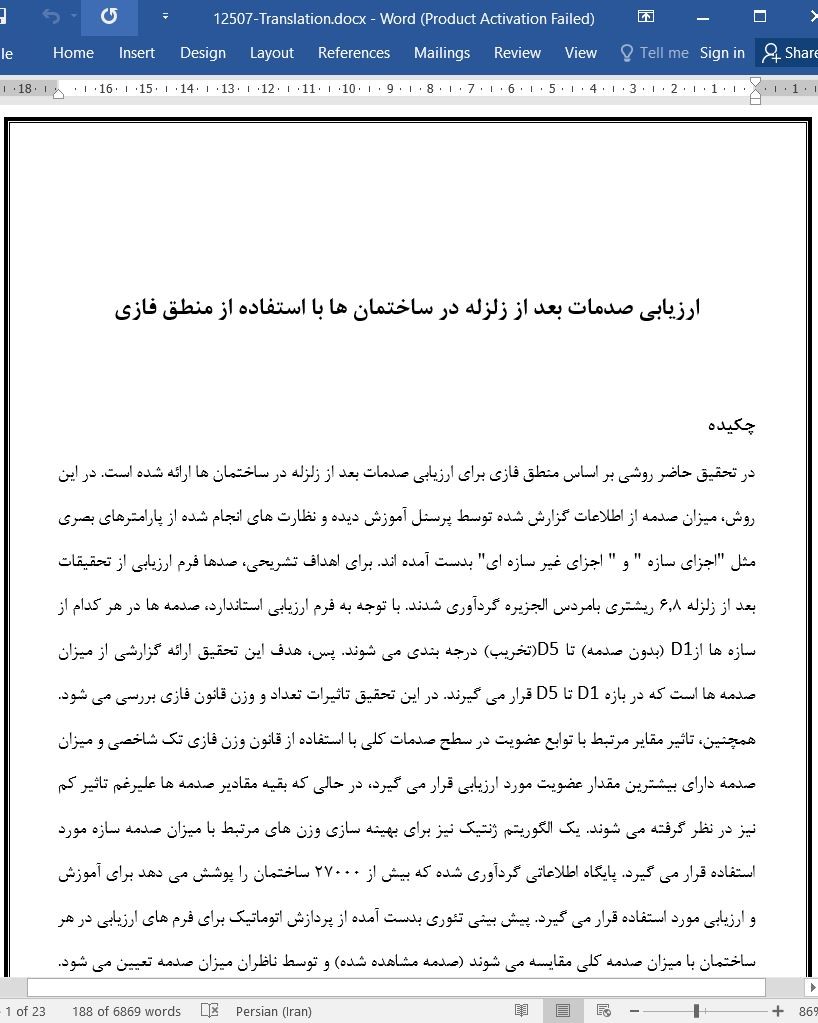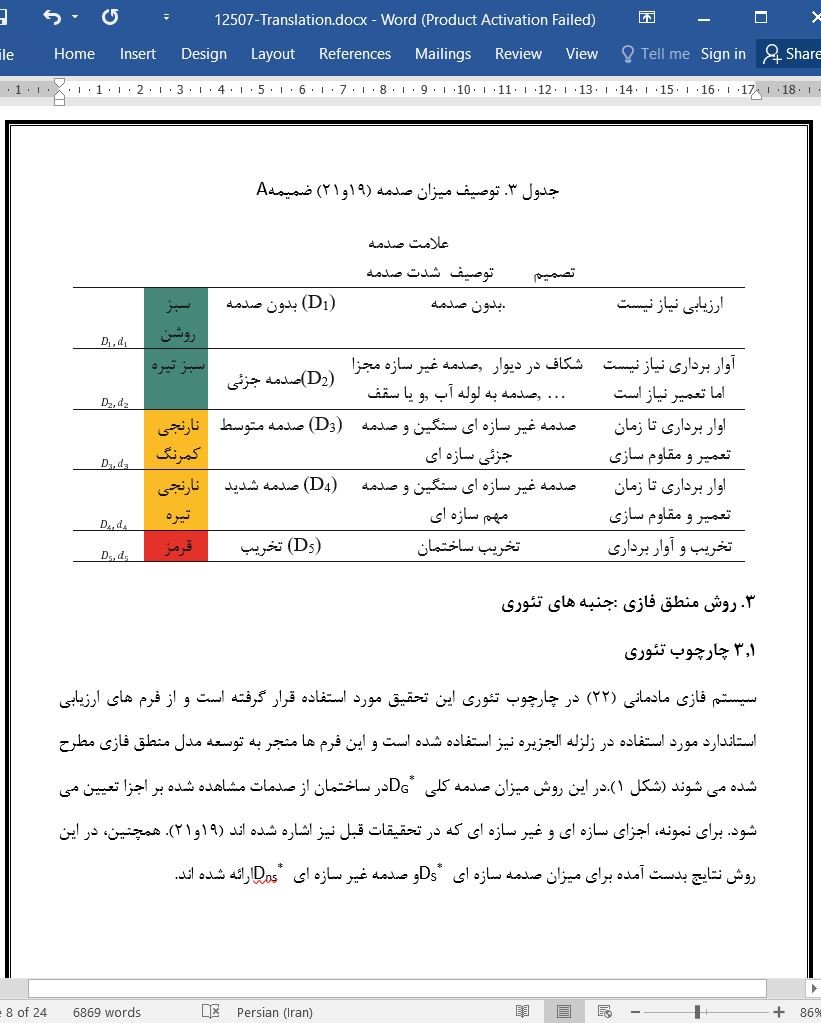
دانلود مقاله ارزیابی صدمات بعد از زلزله در ساختمان ها با استفاده از منطق فازی
چکیده
در تحقیق حاضر روشی بر اساس منطق فازی برای ارزیابی صدمات بعد از زلزله در ساختمان ها ارائه شده است. در این روش، میزان صدمه از اطلاعات گزارش شده توسط پرسنل آموزش دیده و نظارت های انجام شده از پارامترهای بصری مثل "اجزای سازه " و " اجزای غیر سازه ای" بدست آمده اند. برای اهداف تشریحی، صدها فرم ارزیابی از تحقیقات بعد از زلزله 6.8 ریشتری بامردس الجزیره گردآوری شدند. با توجه به فرم ارزیابی استاندارد، صدمه ها در هر کدام از سازه ها ازD1 (بدون صدمه) تا D5(تخریب) درجه بندی می شوند. پس، هدف این تحقیق ارائه گزارشی از میزان صدمه ها است که در بازه D1 تا D5 قرار می گیرند. در این تحقیق تاثیرات تعداد و وزن قانون فازی بررسی می شود. همچنین، تاثیر مقایر مرتبط با توابع عضویت در سطح صدمات کلی با استفاده از قانون وزن فازی تک شاخصی و میزان صدمه دارای بیشترین مقدار عضویت مورد ارزیابی قرار می گیرد، در حالی که بقیه مقادیر صدمه ها علیرغم تاثیر کم نیز در نظر گرفته می شوند. یک الگوریتم ژنتیک نیز برای بهینه سازی وزن های مرتبط با میزان صدمه سازه مورد استفاده قرار می گیرد. پایگاه اطلاعاتی گردآوری شده که بیش از 27000 ساختمان را پوشش می دهد برای آموزش و ارزیابی مورد استفاده قرار می گیرد. پیش بینی تئوری بدست آمده از پردازش اتوماتیک برای فرم های ارزیابی در هر ساختمان با میزان صدمه کلی مقایسه می شوند (صدمه مشاهده شده) و توسط ناظران میزان صدمه تعیین می شود. نتایج نشان می دهد که ارزیابی تئوری متناسب با مقادیر مشاهده شده برای 90 درصد از ساختمان های ارزیابی شده است.
1. مقدمه
زلزله یکی از مخرب ترین پدیده های طبیعی است. این پدیده باعث ایجاد صدمات قابل توجه در بسیاری از بخش های جهان می شود (1). وقوع مکرر زلزله و عواقب آنها در قالب صدمه توجه بسیاری از محققان و مقامات دولتی کشور ها را به خود جلب کرده اند و این عامل باعث توسعه و گسترش قوانین به روز در مدت تصویب قوانین برای افزایش عملکرد ساختمان ها در طول زلزله شده است. به هر حال، ساختمان های متعددی بدون توجه به قاونین زلزله ساخته می شوند و این ساختمان ها عمدتا در برابر زلزله و صدمات بیشتر آسیب پذیر تر هستند.
بعد از یک زلزله، گارشناسان تحقیقات ارزیابی بعد از زلزله انجام می دهند تا میزان صدمات ایجاد شده را ارزیابی کنند. یکی از اهداف اصلی ارزیابی ها، ارزیابی و دسته بندی ساختمان ها در دسته های مختلف با توجه به میزان صدمه آنها است. بسیاری از ساختمان های صدمه دیده بخصوص در موقعیت وقوع تکان های زمین آسیب پذیر و خطرناک هستند. ساختمان های ناامن باید ارزیابی شوند و سکونت در آنها محدود شود. این دسته بندی به تصمیم گیری در مورد اینکه کدام ساختمان ها برای سکونت امن هستند کمک می کند و نیازمند ارزیابی های بیشتر برای تعمیر و تجدید ساخت می باشند و هر دو عامل برای حفظ ساختمان مهم می باشند.
6. نتیجه گیری
در هنگام بررسی صدمات بعد از زلزله، ارزیابی صدمه ساختمان کار مهمی است. ساختمان های صدمه دیده باید به سرعت و با دقت ارزیابی شوند. بعد از وقوع زلزله های مهم، ناظران همیشه با مشکلاتی در ارزیابی ساختمان های صدمه دیده و ارائه دقیق میزان صدمات کلی مواجه هستند و ناظران غیر متخصص در این فرآیند حاضر می شوند و این عامل منجر به دسته بندی نادرست میزان واقعی صدمه ها می شود. برای غلبه بر این مشکلات و نقاط ضعف، سیستم های کارشناسی برای کمک به نظارت ها در طول مرحله ارزیابی مورد استفاده قرار می گیرند. در این تحقیق یک روش پردازش اتوماتیک ارائه شده است که به ناطران کمک می کند تا در ارزیابی بعد از زلزله عملکرد بهتری داشته باشند. روش مطرح شده به ارزیابی میزان صدمات کلی می پردازد و اطلاعات نادرست و ناقص را نیز در نظر می گیرد. این روش متمرکز بر میزان صدمه مشاهده شده در هر کدام از "اجزای سازه ای " (ستون ها، تیرها، دیوارها، تکه سنگ ها و "اجزای غیر سازه ای" (راه پله ها، دیوارهای جدا کننده، نما، بالکون و غیره) می باشد.
Abstract
The present paper develops a methodology based on fuzzy logic for post-earthquake assessment of buildings damage. It derives the global building damage level from that reported information by trained technical staff, after in-situ visual inspection of the main parameters, i.e., the “Structural components” and the “Non-structural components”. For illustration purposes, thousands of evaluation forms from post-earthquake survey following the 2003 Boumerdes, Algeria, earthquake (Mw = 6.8) have been collected. According to the standard evaluation form, each component’s damage is ranked from D1 (No damage) up to D5 (Collapse). The aim is then to derive the global damage level of buildings which should also rank from D1 to D5. The paper investigates the effect of the number and weights of fuzzy rules to relate each components’ damage level to the global damage level using a single-antecedent weighted fuzzy rule. It investigates also the effect of membership functions values so that it is possible to consider one damage level as the most dominant with highest membership value whereas the rest damage levels are still considered although with lower influence. A genetic algorithm is adopted to optimize the rule weights associated to the components’ damage levels. The collected database which covers more than 27,000 buildings is used to train and validate the procedure. The theoretical prediction, obtained by automatic processing of the evaluation form for each building, is compared to the global damage (observed damage) identified by inspectors. Results show that the theoretically-based evaluation is in accordance with the observed values for 90% of the investigated buildings.
1. Introduction
Earthquakes are one of the most natural destructive phenomena. They have repeatedly caused considerable losses and casualties in many parts around the world [1]. The frequent occurrence of earthquakes and their consequences in terms of losses got the attention of public authorities of many countries, leading to the development and regularly update their seismic design code to better enhance the performance of buildings during earthquakes. However, numerous buildings have been built with obsolete seismic codes or even without applying any seismic codes and these buildings are mostly more vulnerable to earthquakes and experience more damage.
After an earthquake, experts are deployed for post-earthquake damage survey to assess the incurred damage. One of the main objectives of the assessment tasks is the evaluation and the classification of buildings into different categories with respect to their damage levels. Many damaged buildings are sensitive and hazardous, especially when an aftershock ground shaking occurs. The unsafe buildings must be marked to be evacuated and restricted from occupancy. This classification helps to decide which buildings are safe to occupy, which need more detailed evaluations for reparation and retrofitting purposes, and which are condemned to demolition.
6. Conclusions
When dealing with post-earthquake damage, the assessment of buildings’ damage is a delicate task. Damaged buildings must be evaluated quickly and rigorously. After major earthquakes, inspectors face always difficulties to assess damaged buildings and to derive accurate global damage levels and non-expert inspectors are often involved which can lead to misclassification of real damage level. To overcome these weaknesses, expert systems are used to help inspectors during the assessment tasks. The present paper presented an automatic processing methodology to help inspectors during the assessment of post-earthquake damage. The proposed methodology estimates the global damage level of the buildings by considering even imprecise, uncertain or incomplete information. It relies on the damage levels observed on each of the “Structural components” (columns, beams, walls, slabs, etc.) and the “Non-structural components” (staircases, separation walls, facade, balconies, etc.).
چکیده
1. مقدمه
2. ارزیابی صدمه بعد از زلزله: جنبه های کلی
3. روش منطق فازی :جنبه های تئوری
3.1 چارچوب تئوری
3.2 توسعه و گسترش پارامترهای فازی
4. وزن های قانون فازی : شناسایی
4.1 پیشرفت های تئوری
4.2 فرآیند بهینه سازی
5. کاربرد و مثال عددی
5.1 توصیف پایگاه اطلاعاتی
5.2 محاسبه و مقایسه
6. نتیجه گیری
منابع
ABSTRACT
1. Introduction
2. Post-earthquake damage assessment: General aspects
3. Fuzzy logic approach: Theoretical aspects
3.1. Theoretical framework
3.2. Fuzzy parameters development
4. Fuzzy rule weights: Identification
4.1. Theoretical developments
4.2. Optimization process
5. Application and numerical example
5.1. Description of the database
5.2. Calibration and comparison
6. Conclusions
References
- اصل مقاله انگلیسی با فرمت ورد (word) با قابلیت ویرایش
- ترجمه فارسی مقاله با فرمت ورد (word) با قابلیت ویرایش، بدون آرم سایت ای ترجمه
- ترجمه فارسی مقاله با فرمت pdf، بدون آرم سایت ای ترجمه



